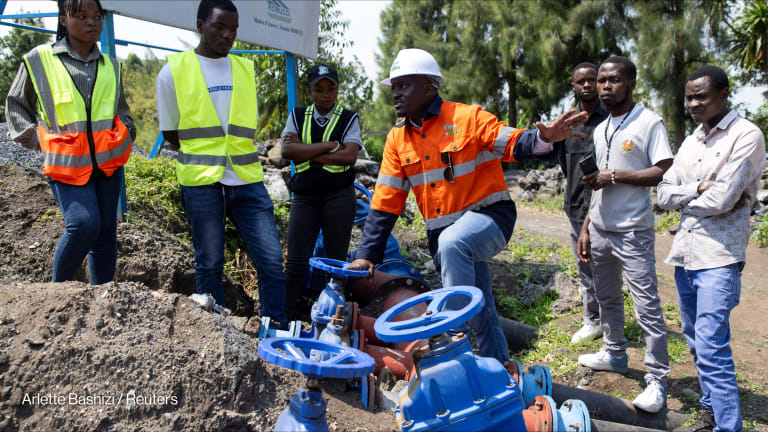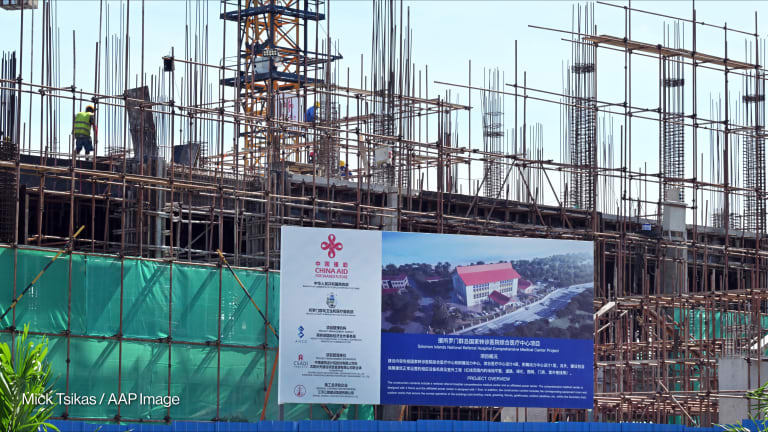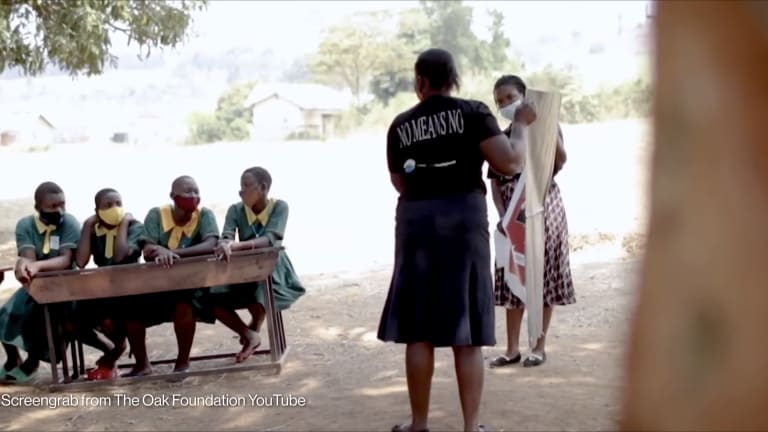How USAID funding for local contractors fell in 2021
The U.S. Agency for International Development obligated $95 million to local suppliers in LMICs in 2021. This accounts for only 1.7% of the agency's total funding for contracts — far from its 25% localization target by 2025.
Over the past few months, Devex has reported extensively on the U.S. Agency for International Development’s funding through its acquisition and assistance mechanisms — which include contracts, grants, and cooperative agreements. Based on USAspending.gov, USAID obligated $5.5 billion through contracts in the fiscal year 2021. We found out that of this amount, only $95 million went to local suppliers in lower-, middle-, and upper-middle-income countries, where local organizations are defined as those implementing projects in their own countries. This represents a 35% fall on the amount obligated in the preceding year. For comparison, USAID’s overall contract spending was also down in 2021, but by a far lower figure — roughly 9%. Local contracting also accounts for just 1.7% of USAID’s total funding obligation for contracts — far less than the 5%, or $840.1 million, the agency awarded to local suppliers through grants. Both figures suggest that USAID still has a lot of work to do to achieve its commitment of channeling 25% of its funding through local partners by 2025. Where did the money go? Overall, USAID obligated $95 million to 402 local contractors in 60 LMICs — down $51.5 million from the previous year. This dip closely relates to a change of funding for Kenya. Contractors in the country received a $3.8 million allocation, but there was a $5.3 million deobligation from the previous year, giving a negative value overall. This is a sharp contrast to fiscal year 2020, when the country ranked first among local suppliers, with $91.2 million of funding. As clarified by USAspending in an email to Devex, a negative value in the data “represent[s] a deobligation to an award and happens for various reasons.” This includes “cancellation or downward adjustment of previously obligated funds.” The total deobligated contract amount in 2021 was $10.6 million — a little less than the $11.4 million in 2020. A further $19.7 million went to 15 LMICs-based contractors for projects in other countries — 23 times more than the $851,500 obligated amount in 2020. However, the increase was solely driven by an $18.7 million contract to Turkish company Bozdemir International for construction services in Malawi. Nearly all of USAID’s contract funding, worth $5.4 billion, went to U.S. contractors for projects in LMICs and other regional and global initiatives. The remainder, worth $17.4 million, was obligated to contractors in other high-income countries. Devex will explore in a future analysis how much USAID money went to LMIC-based organizations through subcontracting. Top-line data from USAspending shows that of the total contracts in 2021, up to $2.2 billion is allocated through subcontracting, of which higher amounts may go to local contractors. However Devex has not analyzed this data in detail, and it includes discrepancies such as duplicates, which suggests actual funding might be much lower than this. Zooming into localization Although down by $68.5 million from the previous fiscal year, Africa and the Middle East remains the biggest recipient of local contracts, with $70.1 million, or 73.8% of the total obligated amount. Of this, $23.4 million went to contractors in North Africa and the Middle East, $20.5 million to Central Africa, $19.6 million to southern Africa, $4.6 million to eastern Africa, and $2 million to West Africa. Asia also received a sizable amount, worth $14.8 million, or 15.6% of the total allocation. Of this, $11.7 million went to East Asia and the Pacific, $2.7 million to South Asia, and $482,000 to Central Asia. Local contractors from Latin America and the Caribbean received $7 million, while their eastern European counterparts received $3 million. Among the countries, Jordan had the most locally implemented contracts, with $19 million — 20% of the total obligated amount. This is up $9.5 million from the previous fiscal year. Uganda ranked next, with $10.7 million — $9 million more than in 2020. Then Rwanda, with $9 million — $8.9 million more than in 2020. Overall, changes in obligation from 2020 to 2021 varied across countries — with some seeing increases, while others having significant reductions. Kenya saw the biggest dip among the countries, from a $91.2 million obligation in 2020 to a $1.5 million deobligation in 2021. There were 23 other countries that saw funding fall, including Egypt, South Africa, and Botswana. On the other hand, 36 countries saw an increase in funding, with the top three countries — Jordan, Uganda, and Rwanda — recording the biggest leap. Top local contractors and activities in 2021 Among the top 10 local contractors, only three were part of the 2020 list — Berytech, Queen Rania Teacher Academy and John Snow Health Zambia. The remaining seven did not receive any funding obligation in the previous fiscal year. Rwanda Medical Supply Limited ranked first among local partners in fiscal year 2021, with $9 million. Vina Marine Construction Joint Stock Company followed, with $8.6 million, while Joint Medical Store, with $8.1 million, and Bitar Muhandisoun Mustasharoun, with $5.7 million, rounded off the top four. The other top suppliers are KPMG Advisory Services Private Limited, Bolloré Transport & Logistics, and Right to Care Zambia. Overall, the top 10 contractors received $52.9 million, or 55.7% of the total funding in 2021. The top awardees will also implement the biggest local activities. These include: • $8.6 million to Vina Marine Construction Joint Stock Company for services related to dioxin remediation at Bien Hoa Air Base in Vietnam. • $8.4 million to Rwanda Medical Supply Limited for HIV/AIDS commodities procurement and distribution in Rwanda. • $8.1 million to Joint Medical Store for procurement and delivery of commodities for care and treatment of persons with HIV in Uganda. • $4.7 million to Bitar Muhandisoun Mustasharoun for planning and design services for new public schools in Jordan. • $4 million to KPMG Advisory Services Private Limited to support water and sanitation activities in India. A comparison with the previous year’s list showed that 2020’s top contractor Kenya Medical Supplies Authority recorded a deobligation in 2021, worth $4.7 million. Three others from the 2020 top list still ranked among the biggest suppliers in 2021, albeit not in the top 10: Engicon ranked 11th; the Association of Private Health Facilities in Tanzania ranked 12th; and Cipla Foundation ranked 26th. All the other former top contractors did not receive any obligation in 2021. Try out Devex Pro Funding today with a free five-day trial, and explore funding opportunities from over 850 sources in addition to our analysis and news content.
Over the past few months, Devex has reported extensively on the U.S. Agency for International Development’s funding through its acquisition and assistance mechanisms — which include contracts, grants, and cooperative agreements.
Based on USAspending.gov, USAID obligated $5.5 billion through contracts in the fiscal year 2021.
We found out that of this amount, only $95 million went to local suppliers in lower-, middle-, and upper-middle-income countries, where local organizations are defined as those implementing projects in their own countries.
This story is forDevex Promembers
Unlock this story now with a 15-day free trial of Devex Pro.
With a Devex Pro subscription you'll get access to deeper analysis and exclusive insights from our reporters and analysts.
Start my free trialRequest a group subscription Printing articles to share with others is a breach of our terms and conditions and copyright policy. Please use the sharing options on the left side of the article. Devex Pro members may share up to 10 articles per month using the Pro share tool ( ).
Miguel Tamonan is a Senior Development Analyst at Devex, where he analyzes data from public and private donors to produce content and special reports for Pro and Pro Funding readers. He has a bachelor’s degree in Political Science with a Major in International Relations from the Polytechnic University of the Philippines.








